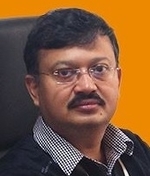3-2 What makes localization more important for the future international business.
パネリスト:
Anne-Marie Colliander Lind
コリアンダー・リンド・アンネ-マリエ
Anne-Marie Colliander Lind is a recognised force in the European language industry landscape. She has spent more than 25 years helping multinational organizations solve their language issues, serving in executive sales and management positions at leading service, technology and market research companies. Currently, Anne-Marie has a part time position serving as Marketing Manager at LocWorld, the leading conference for international business, translation, localization, and global website management. She is also the owner of Inkrease, a business consulting company based in Sweden that assists companies in their growth and development strategies. Anne-Marie is the chairman of the Swedish Association for Translation Companies, runs fundraising activities for Translators without Borders and organizes localization and technology events in the Nordics.
ラス・ビラジ Biraj Rath
Biraj Rath is one of the founding members of Braahmam Net Solutions in India, specializing in customer design and delivery of products and services for the Indian market. He works mainly with large multinational customers in education, training, software and telecom. He is an authority on localization of digital learning technologies with an emphasis on multimedia. Biraj has delivered papers at Localization World, LISA, British Council Forums, CII and IIT. He currently serves as an Ambassador for the Globalization and Localization Association (GALA).
ウエダ・ユカコ Yukako Ueda
Yukako Ueda launched the Japan chapter of Women in Localization, non-profit organization for women working in the localization industry, in March 2015. Yukako is APAC Lead of Global Content Management at NetApp, responsible for the localization quality of 4 APAC languages.
モデレーター:
イノウエ・ケン Ken Inoue
Ken Inoue has over 23 years of professional experience in software engineering and technologies, including localization, and machine translation and localization tools development. Currently, Ken is CTO of Global Studios Consulting in Seattle.
報告者:三宅理恵 Rie Miyake
Localization around you
Biraj
Only 7-8% of people in India speak English. Yet many people pretend to know English. As an example, in India, there are many English signboards on the shops with several errors and spelling mistakes. Many are really funny ones. You can even write a book about them.
Anne-Marie
English proficiency as a second language is amongst the highest in the world in Sweden. But Sweden also has a large number of immigrants, which makes Finnish and Arabic the second and third most commonly spoken languages besides Swedish.
Yuka
In spite of the long period of learning it, not many Japanese can speak English, though they are good at reading it.
This is supposedly because they don’t have to speak English.
Localization - Today & Tomorrow
(Roles of people in localization and their happiness)
Anne-Marie
In localization, not only linguists and translators, but also engineers, terminologists, etc., play equally important roles to provide services.
Yuka
How happy a translator is depends on his/her vendor, and how happy the vendor is depends on their clients.
Biraj
The problem is whether the profession is of my choice, or I am forced to do the job.
If we can acquire knowledge and opportunity for learning, we are happy.
Anne-Marie
Technology is a headache for many LSPs. Speed of development of technology is stressful.
Whether one is happy or unhappy is quite close to passion and what you like.
Yuka
2 factors decides the happiness, if they can enjoy the job, and if they can get sufficient revenue from the job.
Whether MT makes people happy or unhappy
Yuka
More and more companies introduce machine translation (MT), and the work of a translator is being transformed into post-editing (PE) of machine translation outputs. They don’t look enjoying the PE work now because they cannot become happy until the technology gets matured. Once the quality is improved, they must become happier.
Biraj
MT will be used for user generated content on social content in which people are not so sensitive about quality.
MT is good in terms of speed, cost, etc.
However, MT will not replace translators.
MT cannot be used for such domains as medical, pharmaceuticals, etc.
It takes long time for MT to be widely used.
Anne-Marie
Nowadays, people open up a lot of content, and people wish to translate it through MT and get the meaning instantly. This drives the need for more human translation.
Future Needs for Translation
Anne-Marie
Only a small on-line content (that is necessary) is translated.
The more global we become, the more local language we need.
In the field of healthcare, court, etc., we will always need local language.
Therefore, the future is bright.
Yuka
Farther into the future when more and more Japanese people will be able to use English very well, I can say we will find less opportunity in the area of just translating Product Manuals or UIs because the amount of work depends on the requirements, However, we are having more opportunities in TransCreation that can be done only by Human Translation.
Biraj
Translation in India is generally not considered a serious profession. It is performed as a part-time after office activity for extra cash. Therefore, the average skill level of translators remains low among available translators.
About Technology
Anne-Marie
Main change is speed.
Small chunks of information need to be delivered in a short time, simultaneously in many markets.
Automization of processes is thus required.
Biraj
Change or innovation is linked to people.
If one looks for a different business model and wants to earn more money, different business model is required from the present one.
Volume of translation is getting smaller
Biraj
Agile model works well in software.However, this model does not work for all.
Yuka
Besides having smaller size of the projects brought by the Agile and xml-based development lifecycles, the need for technology integration is increasing. Content repositories, content distribution platforms, and translation management will be fully connected. In such automated environments, I can expect more requirements for the translators to think and find the whole contexts and background info to provide with the value-added translations because it must become harder and harder for Project Managers to understand them for all projects.
Biraj
Business model is all temporary, and nothing is permanent.
If I may add a geographic perspective, in less fortunate countries including India, there is a problem of lack of Internet and education, etc.
Please note the gap - still many people don’t get there.
Anne-Marie
Need for translation of voice and multimedia, and other types, and texts are increasing.
User-interactive platform is flourished.
It is important news that Google started video translation services.



